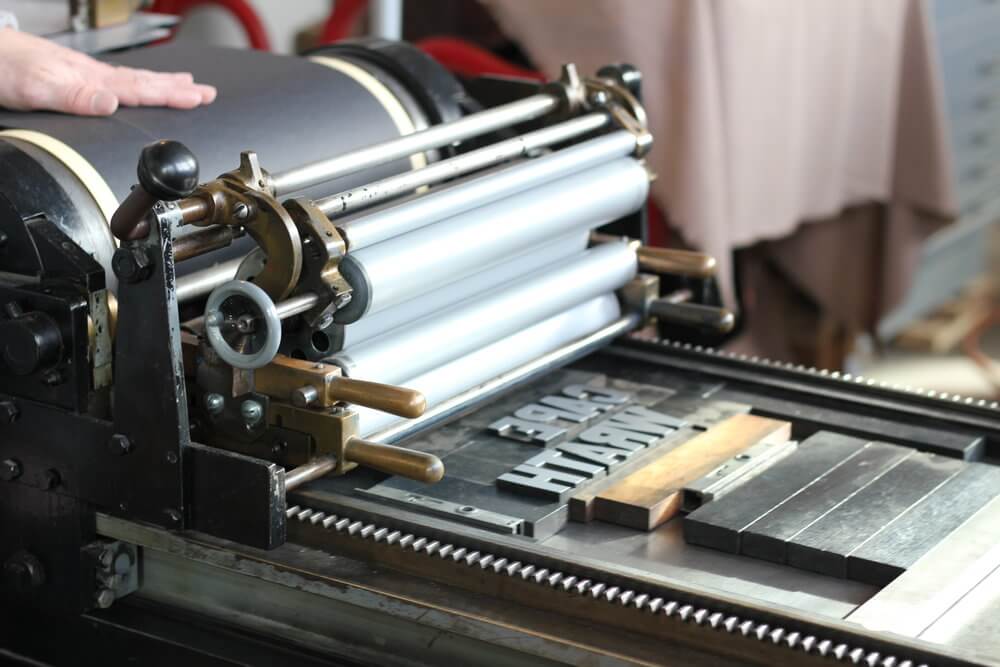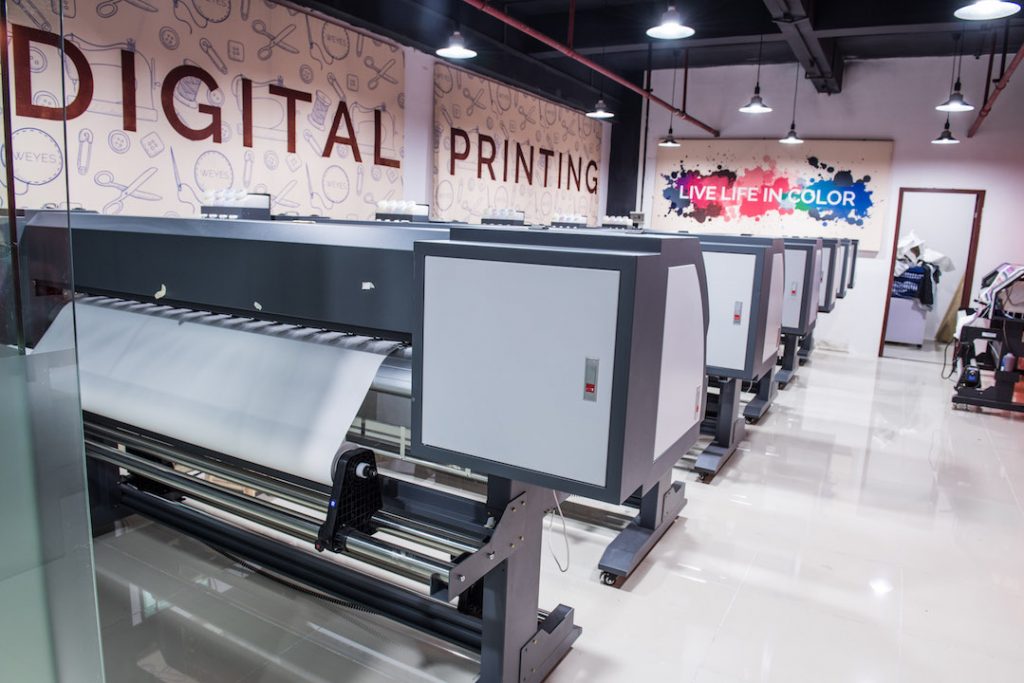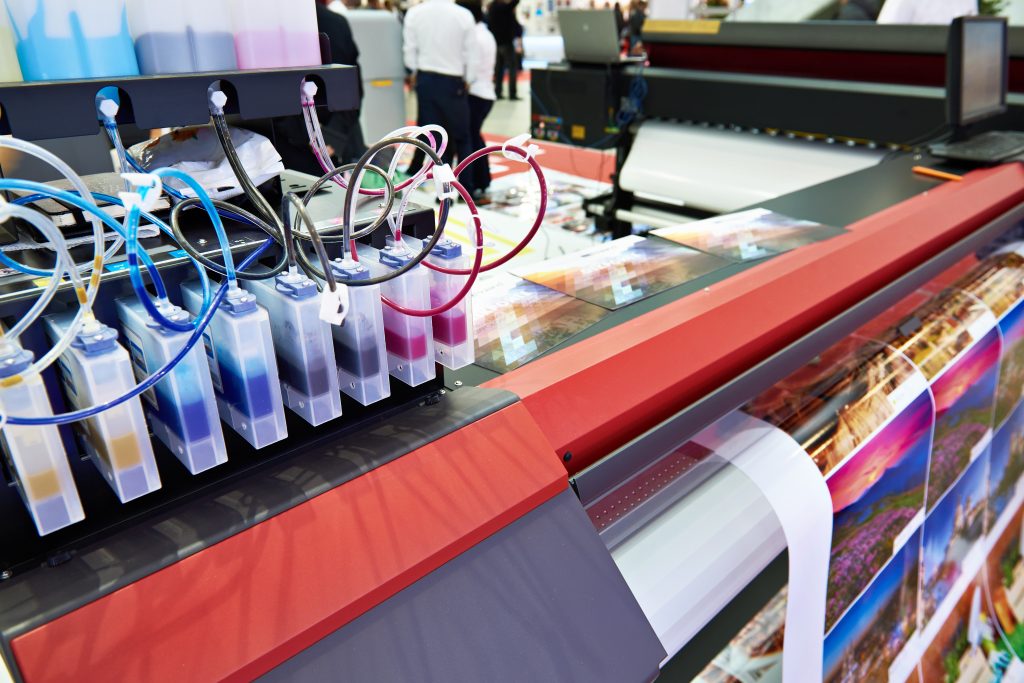- Traditional printing and existing problems
There are many kinds of traditional printing, such as hand printing, flat screen printing, direct printing, discharge printing, anti-dye printing, rotary screen printing, etc. Now, the traditional printing process is quite mature, the most common is rotary screen printing and flat screen printing. Rotary screen printing is a printing method in which the color paste in the rotary screen is printed on the fabric under the pressure of a scraper. The rotary screen can be completed after more than a dozen processes, and it can engrave very precise fine lines. Can print detailed and soft patterns; flat screen printing uses flat screen printing technology, there are three types of manual platen type, semi-automatic plate To find out the unit pattern of the cycle, the production speed is slower and the output is lower.

Printing technology has developed so far, and it has formed a pattern in which two forms of traditional printing and digital printing coexist. In our country, digital printing is in its infancy, while traditional printing, especially in mass printing production mode, is in an absolute leading position in the market. However, after years of technological updates and the development of digital printing, the problems of traditional printing have become more and more obvious:
1. In accordance with the requirements of environmental protection, traditional printing consumes a lot of water and electricity, consumes a lot of energy, and causes serious pollution;
2. Due to the limitation of color registration, one printing machine can only print more than a dozen colors at the same time, and the natural gradient colors cannot be printed and dyed;
3. Due to the restriction of plate making, the size of the pattern is also restricted, and the pattern that is too large cannot be printed and dyed;
4. Due to time and cost constraints, the plate-making time is too long and the process is cumbersome, while small batches and personalized orders are slow to respond and costly;
5. The pattern requirement is a color-separable pattern with a certain repeating pattern, otherwise it cannot be printed, which limits the designer’s pattern design.
- The advantages of digital printing
“Digital printing”, as the name implies, is printing using digital technology. Digital printing technology is a high-tech product that integrates machinery, computer and electronic information technology gradually formed with the continuous development of computer technology. The emergence and continuous improvement of this technology has brought a brand new concept to the textile printing and dyeing industry.

The production process of digital printing is simply to pass various digital means such as scanning, digital photos, images or various digital patterns produced and processed by the computer into the computer, and then processed by the computer pink printing system, and then sprayed by special software. The printing system directly sprays various special dyes onto various plants or other media, and after processing, obtains various high-precision printing products required on various textile fabrics. Compared with the traditional printing process The difference is:
1. Technical advantages
Since China entered the post-quota era, the textile printing and dyeing, clothing, and home textile industries have become dominant industries. The domestic consumption level has greatly increased, and the opportunities for export trade have increased sharply. The domestic textile market is “individualized, small batch, fast consumption, and green”. Such labels have become fashionable needs, which are brought about by the introduction of digital printing technology and independent domestic research and development, and at the same time have created unprecedented opportunities for the textile industry. Compared with traditional printing process, digital printing technology has the following main advantages:
(1) Computer software design pattern
The whole digital digital printing shows that the process from design to production is controlled by a computer. The most important thing is the pattern design. The pattern design is carried out by the designer through the computer-aided design software, without any restrictions, and can be modified to the customer’s satisfaction. .
(2) High printing accuracy
The accuracy of digital printing can reach more than 2000dpi, and the fineness of the printed image can be comparable to that of photos, achieving 3D realistic three-dimensional effect, and at the same time, it can also print the gradual color transition from deep to light and multi-color. Digital printing adopts four basic colors CMYK, namely blue-green, magenta, yellow, and black, plus 2-4 special colors, namely golden, orange, red, and blue. It can print as many as 16.7 million kinds of pattern colors. The color gamut is wide and the colors are bright. Breaking through the color registration limitation of traditional textile printing and dyeing patterns, especially in the printing of high-precision patterns such as color gradients and moiré patterns, digital printing has unparalleled technical advantages. In addition, traditional printing patterns are often limited by the length of “flower back”, while the concept of “flower back” may not exist in the process of digital printing, which greatly expands the space for textile pattern design and improves the quality of products.
(3) Quick response, pursuit of individualization
Digital printing can quickly respond to popular elements. The fashion cycle of clothing is getting shorter and shorter, and the pattern changes are becoming more and more diverse. The emerging fashion patterns can be imitated, redesigned, and produced immediately to meet market demand. ; Consumers can also design patterns that suit them according to fashion trends, tailor them, or use photographic works to pursue a unique psychology.
(4) Small batch production
Digital printing realizes printing from one meter, realizing small batch production. Digital printing does not require processes such as color separation, drafting, screen making, and color paste adjustment, which saves time for customers and reduces printing costs. Customers only need to provide the pattern design manuscript, free customization, single piece, multiple pieces, one meter kilometer All are acceptable for production.
Digital printing production truly realizes a small batch, fast response production process, and the production batch is not subject to any restrictions. As the digital printing production process all realizes computerized digital production, the flexibility of production is greatly improved, and some products can even be delivered on the same day, which is immediately desirable. In addition, due to the application of computer technology, printing a series of patterns with different tones of the same pattern, as well as the designer’s continuous modification of the colors during the production process, has become a major technical advantage of digital printing production that is different from traditional printing production.
(5) Storage of craft files
The data and process plan needed in the digital printing process are all stored in the computer, which can ensure the reproducibility of the printing. In the traditional rotary screen printing production, the preservation of archives is a headache. The storage of manuscripts and the storage of rotary screens take up a lot of space, which is a waste of manpower and material resources. At the same time, the preservation effect is not very good.
(6) Green environmental protection
Digital printing is mainly controlled by computer, which can achieve “distribution on demand”. The printing process does not require water and color paste, there is no waste of dyes and waste water, and the equipment is printed and dyed without noise pollution and realizes green production.
2. design advantages
Digital printing uses digital technology to create a brand-new pattern style in fabric pattern design on the one hand, and on the other hand it completes an innovation in human art design. On the whole, the fabric pattern design of digital printing is done by computer-aided design software, such as Photoshop, illustrator, coreldraw and other design software, using certain tools or image and graphics processing functions to design the pattern, or by both hand-painting and design software. Combine to complete the pattern design. Compared with traditional handmade pattern design, the advantages of digital printing design are specifically manifested in:
(1) Suitable curve change
Using computer-aided design software curve tools to draw curves will make the curve expression smoother (such as 3). When drawing with illustrator, coreldraw and other software, if you feel unsatisfied, you can adjust and return to the previous step to re-operate at any time.
(2) Quick and repeatable design
Oscar Ward said: “The repetitive patterns make people feel comfortable, and the miracle of design inspires our imagination.” Repetitive elements are generally referred to as comfortable and balanced design. Computer-aided design of repeated patterns has unique advantages. In the process of fabric pattern design, the designer only needs to design one unit element, and then use the arrangement tool in computer-aided design software to repeat the unit element arbitrarily, which seems to be a complicated arrangement and combination. However, computer-aided design is particularly simple and easy.
(3) Advantages of color design changes
The computer stores various color data, and uses computer-aided design software color adjustment tools to adjust the different hues, shades, and saturations of the pattern single background color and multiple background colors, change colors, and create color combinations. The same pattern, but the color of each pattern is different, the use of computer-aided software functions to change the color in a short time, intuitively showing the advantages of multiple color changes.
(4) Natural transition effect
When drawing gradient colors, you only need to use computer-aided design software gradient tools to select one or more colors for color gradient, and you can also adjust the width and breadth of the gradient. It is easy to operate, and the gradient effect is natural and soft, without obvious Color scale.
(5) Three-dimensional pattern design
Nowadays, fabric patterns show a diversified development trend. Many designers use the advantages of digital printing technology to design patterns by scanning documents, photographs, and three-dimensional patterns. Use computer-aided design to import three-dimensional images into the software, and use three-dimensional effect tools or hand-drawing methods to show another new pattern.

In which areas can digital printing be used:
1. Personalized gift market, the domestic gift market has reached 9.8 billion, which has become a popular trend in gifts. Print your own photos or favorite pictures, icons, and texts on the gifts to get rid of the gift’s stereotyped faces, which can better reflect the value of the gift and the unique ingenuity of the gift giver.
2. The home decoration market, the domestic home decoration market has reached tens of billions, and the personalized home decoration is also quietly popular.
Users can print their favorite photos or images on decorative paintings, tiles, furniture, and floors according to their favorite home style. At present, a latest technology can directly perform thermal transfer on the wall and print the desired pictures directly. On the wall, decorate your home with your favorite style, and create a space of your own personality. This has gradually become a popular trend, and a new industry term is called wall digital printing.
3. In the personalized product market, a considerable part of the users in the popular mobile phone and digital product market are young and fashionable groups. Printing your own logo on these products is the best embodiment of individuality.
Some carry-on items, such as vanity mirrors, lighters, wallets, backpacks, etc., are also a good way for these users to reflect their personalities.
4. Personalized image consumer products, digital images are developing rapidly, and people are no longer limited to printing their photos on photographic paper. The universal digital printing system can print any image on crystal, glass, acrylic, metal, ceramic, canvas, etc. The effects and feelings of products printed on different materials are different. People can print their photos on different materials, which enriches the expression and effects of the photos.
5. Popular cultural peripheral products, the universal digital printing system can also conveniently print some popular movies, animations, HIP-HOP and other pictures or popular elements on some items according to popular trends.
6. Advertising and sign market, high-quality, high-price, medium and small batch advertising and sign production, such as all kinds of metal membership cards, attendance cards, badges, listings, authorization cards, and other full-color printing, which is difficult to achieve with printing technology.
7. professional proofing
one-time molding, no plate making, part of the material can be used repeatedly, low cost; computer direct typesetting, modification, production, simple operation, high efficiency, greatly reducing costs.
8. Leather digital printing
For the printing of leather accessories such as belts, purses, cosmetic bags, handbags, key cases, suitcases, etc., not only the quality is guaranteed, but the colors are bright and realistic, with high washing fastness, UV protection, non-toxic and environmentally friendly. When the LOGE leather printing machine prints, the nozzle and the media surface are non-contact, and will not deform due to heat and pressure. Therefore, it can also print on materials that are easily deformed and soft (such as leather and textiles). LOGE leather printing machine overcomes the shortcomings of leather products that cannot be printed in multiple colors due to elasticity, and also overcomes the effect of poor layered fidelity. It provides a new and practical way for the digitalization process of the printing industry. The emergence of this new technology will undoubtedly bring a brand new business opportunity to the leather industry!
| M | T | W | T | F | S | S |
|---|---|---|---|---|---|---|
| 1 | 2 | 3 | 4 | 5 | 6 | |
| 7 | 8 | 9 | 10 | 11 | 12 | 13 |
| 14 | 15 | 16 | 17 | 18 | 19 | 20 |
| 21 | 22 | 23 | 24 | 25 | 26 | 27 |
| 28 | 29 | 30 | ||||
Recent Posts
- Ultimate Guide to UV Printing: Insider Tips and Tricks
- Before You Invest: Choosing a Large Format Flatbed Printer
- Maximizing Brilliance: Mastering UV Printer Settings for Optimal Media Reflectivity
- The advantages of using a WER UV printer for large format printing (2)
- Achieve Stunning Results in Home Décor and Architectural Design with UV Printer
Archives
- January 2025
- November 2024
- September 2024
- March 2024
- December 2023
- November 2023
- October 2023
- May 2023
- March 2023
- February 2023
- January 2023
- December 2022
- November 2022
- October 2022
- September 2022
- February 2022
- January 2022
- December 2021
- November 2021
- October 2021
- September 2021
- August 2021
- July 2021
- June 2021
- May 2021
- April 2021
- March 2021
- February 2021
- January 2021
- December 2020
- November 2020
- October 2020
- September 2020
- August 2020
- July 2020
- June 2020
- May 2020
- April 2020
- March 2020
- February 2020
- January 2020
- December 2019
- November 2019
- October 2019
- September 2019
- August 2019
- July 2019
- June 2019
- May 2019
- April 2019
- March 2019
- February 2019
- January 2019
- December 2018
- November 2018
- October 2018
- September 2018
- August 2018
- July 2018
- June 2018
- May 2018
- April 2018
- March 2018
- February 2018
- January 2018
- December 2017
- July 2016
- June 2016
Recent Posts
- Ultimate Guide to UV Printing: Insider Tips and Tricks
- Before You Invest: Choosing a Large Format Flatbed Printer
- Maximizing Brilliance: Mastering UV Printer Settings for Optimal Media Reflectivity
- The advantages of using a WER UV printer for large format printing (2)
- Achieve Stunning Results in Home Décor and Architectural Design with UV Printer